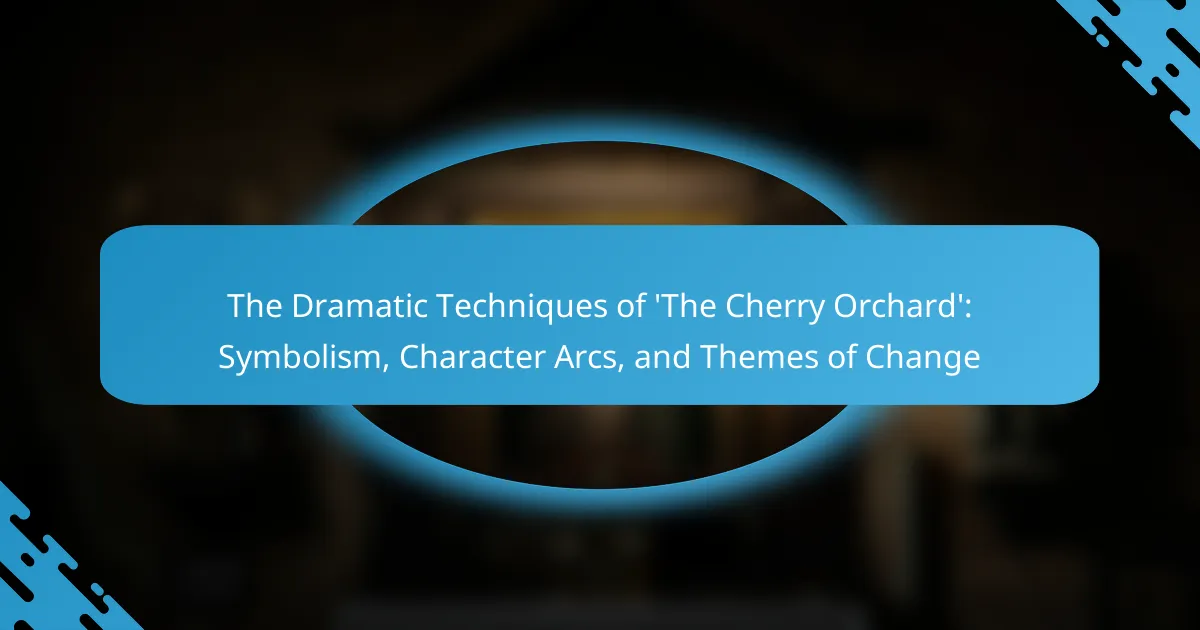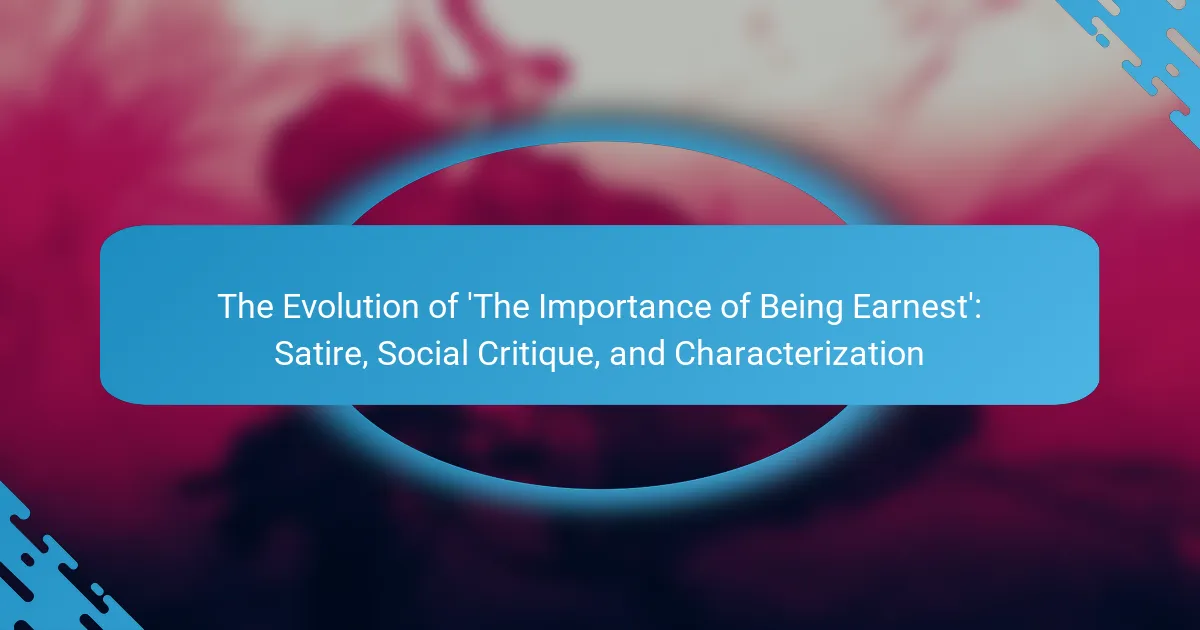‘The Crucible’ is a play by Arthur Miller that explores the Salem witch trials of 1692, a period characterized by mass hysteria and societal paranoia driven by Puritan beliefs. The article analyzes the historical context of the trials, drawing parallels to the McCarthy hearings during the Red Scare in the 1950s, highlighting themes of fear, morality, and the consequences of personal motivations. Key themes include the irrational behavior stemming from mass hysteria, the fear of the unknown, and the impact of personal vendettas on community dynamics. Character motivations such as self-preservation, desire for power, and the quest for redemption are examined, revealing how these factors contribute to the tragic outcomes in the play. Understanding these elements is crucial for comprehending the broader implications of fear and injustice in both the historical and literary contexts.

What is the historical context of ‘The Crucible’?
‘The Crucible’ is set during the Salem witch trials of 1692. These trials were a series of hearings and prosecutions of people accused of witchcraft in colonial Massachusetts. The historical context reflects the societal fears and paranoia of the time. Puritan beliefs heavily influenced the community’s actions and judgments. The play was written by Arthur Miller in 1953, during the Red Scare. This was a period marked by intense anti-communist sentiment in the United States. Miller drew parallels between the witch trials and the McCarthy hearings. Both events showcased how fear can lead to mass hysteria and injustice. The historical context is essential to understanding the themes of fear and morality in the play.
How did the Salem witch trials influence ‘The Crucible’?
The Salem witch trials significantly influenced ‘The Crucible’ by providing a historical backdrop for its themes of hysteria and injustice. Arthur Miller wrote the play as an allegory for McCarthyism, drawing parallels between the witch hunts and the Red Scare. Both events showcase how fear can lead to irrational behavior and the persecution of innocent people. The trials highlight the consequences of mass paranoia, a central theme in Miller’s work. Additionally, the character motivations in ‘The Crucible’ reflect the societal pressures and moral dilemmas faced during the trials. The historical context of the Salem witch trials serves as a warning against the dangers of extremism and scapegoating.
What were the social and political conditions in Salem during the trials?
The social and political conditions in Salem during the trials were characterized by paranoia and instability. The community was deeply divided, with tensions heightened by recent conflicts and fear of the unknown. Salem was influenced by Puritan beliefs, which emphasized a strict moral code and a fear of witchcraft. The political structure was weak, with local leaders struggling to maintain order amidst the chaos. The trials were fueled by personal grievances and rivalries, leading to accusations that often stemmed from jealousy or revenge. Additionally, the influence of religious authorities played a significant role in the trials, as they sought to uphold their power through the prosecution of alleged witches. The combination of these factors created an environment ripe for hysteria and injustice.
How does Arthur Miller’s background shape the historical narrative?
Arthur Miller’s background significantly influences the historical narrative in his works. He was born in 1915 to a Jewish family in New York City. This upbringing exposed him to the struggles of immigrant life and the impact of economic hardship. During the Great Depression, Miller witnessed social injustice and the effects of fear on society. His experiences during the McCarthy era shaped his views on political oppression and conformity. Miller’s play “The Crucible” reflects these themes through the Salem witch trials as an allegory for the Red Scare. The characters in “The Crucible” embody the consequences of fear and hysteria, mirroring Miller’s concerns about society’s moral integrity. Thus, his background provides a lens through which the historical narrative is explored, revealing the interplay between personal experience and broader societal issues.
What role does McCarthyism play in ‘The Crucible’?
McCarthyism serves as a critical backdrop in ‘The Crucible’. The play, written by Arthur Miller, parallels the anti-communist hysteria of the 1950s. Just as individuals were accused of communism without evidence, characters in the play face baseless accusations of witchcraft. This creates an atmosphere of fear and paranoia. Characters like John Proctor and Elizabeth Proctor embody the struggle against mass hysteria. The consequences of false accusations lead to tragic outcomes in both the play and real-life McCarthyism. Miller’s work critiques the dangers of extremism and the loss of rationality in society.
How does the fear of communism parallel the fear of witchcraft?
The fear of communism parallels the fear of witchcraft in that both stem from societal anxieties about the unknown and the perceived threat to social order. During the Salem witch trials, individuals were accused of witchcraft based on suspicion and paranoia. This led to widespread hysteria and unjust trials. Similarly, the Red Scare in the 20th century involved accusations of communism without substantial evidence. Both phenomena resulted in scapegoating and the persecution of innocent people. In both cases, fear was manipulated to consolidate power and control public opinion. Historical events demonstrate how fear can lead to irrational actions and societal division.
What impact did McCarthyism have on American society in the 1950s?
McCarthyism significantly impacted American society in the 1950s by fostering a climate of fear and suspicion. This period was characterized by widespread anti-communist sentiment. Many individuals faced accusations without substantial evidence. The government conducted investigations that led to blacklisting in various industries. Public figures, including artists and intellectuals, were particularly affected. The House Un-American Activities Committee (HUAC) played a crucial role in these investigations. The Red Scare influenced political discourse and civil liberties. Many Americans lived in fear of being labeled as communists or sympathizers. This atmosphere of paranoia was reflected in literature and media of the time, including Arthur Miller’s play “The Crucible.”

What are the central themes of fear in ‘The Crucible’?
The central themes of fear in ‘The Crucible’ include mass hysteria, the fear of the unknown, and the consequences of personal vendettas. Mass hysteria drives the characters to irrational behavior. This fear leads to false accusations and unjust punishments. The fear of the unknown manifests in the community’s response to witchcraft. Characters like Abigail Williams exploit this fear for personal gain. Additionally, fear of social ostracism compels individuals to conform. This theme reflects the historical context of McCarthyism. The consequences of fear result in tragedy and loss of integrity. Fear ultimately undermines reason and justice in the community.
How does fear manifest among the characters in ‘The Crucible’?
Fear manifests among the characters in ‘The Crucible’ through paranoia, accusations, and self-preservation. Characters like Abigail Williams exploit fear to manipulate others and gain power. Paranoia drives many to falsely accuse their neighbors of witchcraft. This fear of being accused leads to a breakdown of community trust. John Proctor’s fear of losing his reputation compels him to initially remain silent. Elizabeth Proctor expresses fear for her husband’s safety amidst the hysteria. Reverend Hale experiences fear as he realizes the consequences of his actions. The pervasive fear ultimately results in tragic outcomes for many characters.
What are the psychological effects of fear on the community?
Fear can lead to significant psychological effects on a community. It often results in heightened anxiety and stress among individuals. This anxiety can manifest as paranoia, making community members suspicious of one another. Fear can also create a sense of isolation, as people withdraw from social interactions. Additionally, it can lead to groupthink, where individuals conform to the majority opinion to avoid conflict. Historical events, such as the Salem witch trials depicted in “The Crucible,” illustrate how fear can drive irrational behaviors and decisions. In such cases, communities can become divided, with factions forming based on fear-driven beliefs. Ultimately, fear can erode trust and cohesion within a community, leading to long-lasting psychological scars.
How does fear drive the actions of key characters?
Fear drives the actions of key characters in “The Crucible” by influencing their decisions and motivations. Characters like John Proctor act out of fear for their lives and reputations. Abigail Williams manipulates fear to control others and advance her agenda. Reverend Parris exhibits fear of losing his position, leading him to support the witch trials. The townspeople’s fear of the unknown fuels mass hysteria and irrational behavior. Fear of social ostracism compels characters to conform to the majority. This fear-driven behavior reflects historical realities of McCarthyism, where fear led to unjust accusations and paranoia. The characters’ actions demonstrate how fear can override morality and reason.
Why is fear a crucial element in the play’s conflict?
Fear is a crucial element in the play’s conflict because it drives characters to act irrationally. In “The Crucible,” fear of witchcraft leads to mass hysteria in Salem. This fear causes individuals to betray their friends and neighbors to save themselves. The fear of social ostracism and punishment fuels accusations and escalates tensions. Characters like Abigail Williams manipulate fear to gain power and control. The historical context of the Salem witch trials highlights how fear can distort reality. Fear ultimately leads to tragic consequences, including wrongful executions. Thus, fear is not just a theme but a catalyst for the play’s central conflict.
How does fear contribute to the escalation of hysteria?
Fear acts as a catalyst that amplifies hysteria. It triggers emotional responses, leading individuals to react irrationally. In high-stress situations, fear can distort judgment and perception. This is evident in group dynamics, where fear spreads quickly among individuals. Historical events, such as the Salem witch trials depicted in “The Crucible,” illustrate this phenomenon. The characters’ fears of witchcraft led to baseless accusations and mass panic. Research indicates that fear can override logical thinking, fostering an environment ripe for hysteria. In summary, fear fuels hysteria by promoting irrational behavior and collective panic.
What are the consequences of fear on justice and morality?
Fear undermines justice and morality by distorting perceptions and prompting irrational behavior. When individuals act out of fear, they may prioritize self-preservation over ethical considerations. This can lead to false accusations, as seen in the Salem witch trials depicted in “The Crucible.” The fear of social ostracism drove characters to betray their neighbors. Consequently, the legal system becomes compromised, as fear influences verdicts rather than facts. Historical instances, such as McCarthyism, demonstrate how fear can lead to unjust persecution. Ultimately, fear fosters an environment where moral integrity is sacrificed for security.

What are the character motivations in ‘The Crucible’?
The character motivations in ‘The Crucible’ include fear, self-preservation, and desire for power. John Proctor seeks redemption for his past sins. He is motivated by guilt and the need to protect his name. Abigail Williams is driven by her obsession with Proctor. She desires to eliminate Elizabeth Proctor to reclaim his love. Reverend Parris is motivated by self-interest and fear of losing his position. He prioritizes his reputation over the truth. The townspeople are motivated by fear of witchcraft. They seek to protect themselves from the hysteria that consumes Salem. Each character’s motivations intertwine, leading to tragic consequences. The motivations reflect the broader themes of hysteria and moral conflict in the play.
What drives John Proctor’s actions throughout the play?
John Proctor’s actions throughout the play are primarily driven by his desire for redemption. He grapples with guilt over his affair with Abigail Williams. This guilt motivates him to seek truth and justice, particularly when the witch trials escalate. Proctor’s love for his wife, Elizabeth, also influences his decisions. He wants to protect her from the hysteria surrounding the trials. Additionally, Proctor’s commitment to his own integrity pushes him to confront the court. He ultimately chooses to expose the lies of the accusers. His actions reflect a struggle between personal honor and societal pressure. Proctor’s journey illustrates the theme of individual morality versus collective hysteria in the play.
How does guilt influence Proctor’s decisions?
Guilt significantly influences Proctor’s decisions throughout “The Crucible.” His guilt stems from his affair with Abigail Williams. This guilt drives him to seek redemption by confessing to his sins. Proctor’s internal struggle manifests in his reluctance to falsely accuse others. He prioritizes honesty over self-preservation. This moral conflict ultimately leads to his tragic choice to sacrifice himself. Proctor’s decisions reflect a quest for integrity amid societal chaos. His guilt serves as a catalyst for personal transformation and moral clarity.
What does Proctor’s journey reveal about personal integrity?
Proctor’s journey reveals that personal integrity is rooted in the courage to confront one’s own flaws. Throughout “The Crucible,” Proctor struggles with guilt over his affair with Abigail Williams. This internal conflict showcases his initial lack of integrity. As the story progresses, Proctor’s decision to confess to his sins demonstrates a pivotal change. He ultimately chooses to stand for truth, even at the cost of his life. This act of defiance against the unjust court highlights the importance of honesty and moral conviction. Proctor’s final choice to refuse a false confession emphasizes that true integrity requires sacrifice. His journey ultimately illustrates that personal integrity is about aligning one’s actions with one’s values, regardless of societal pressures.
What motivates Abigail Williams in ‘The Crucible’?
Abigail Williams is motivated by a desire for power and love. She seeks to eliminate Elizabeth Proctor to pursue a relationship with John Proctor. Abigail’s actions are driven by jealousy and fear of losing John. Her motivation is further fueled by the oppressive societal norms of Salem. Abigail manipulates the fear of witchcraft to gain influence. She uses the hysteria to position herself as a leader among the other girls. Abigail’s motivations lead to tragic consequences for herself and others. Her character embodies the dangers of unchecked ambition and desire.
How does Abigail’s desire for power affect her relationships?
Abigail’s desire for power significantly strains her relationships. She manipulates others to achieve her goals. This manipulation leads to betrayal and mistrust among her peers. Abigail’s actions create divisions within the community. Her pursuit of authority causes her to alienate those who care for her. For example, she betrays her friends by accusing them of witchcraft. This results in a loss of genuine connections. Ultimately, Abigail’s ambition undermines her ability to form meaningful relationships.
What role does jealousy play in Abigail’s actions?
Jealousy is a significant motivator for Abigail’s actions in “The Crucible.” Her jealousy primarily stems from her feelings for John Proctor. Abigail desires John, who is married to Elizabeth Proctor. This unreciprocated love drives Abigail to eliminate Elizabeth. Abigail’s jealousy fuels her manipulative behavior throughout the play. She falsely accuses Elizabeth of witchcraft to remove her rival. This jealousy leads to a series of tragic events in Salem. Ultimately, Abigail’s actions reveal the destructive power of jealousy in human relationships.
How do the motivations of supporting characters impact the narrative?
The motivations of supporting characters significantly impact the narrative by shaping the main character’s decisions and actions. In “The Crucible,” characters like John Proctor and Abigail Williams drive the plot through their desires and conflicts. Proctor’s guilt and need for redemption influence his choices, leading to pivotal moments in the story. Abigail’s obsession with Proctor creates tension and propels the witch trials. Their motivations reveal themes of fear, power, and morality. This dynamic illustrates how supporting characters can alter the protagonist’s journey and the overall message of the narrative.
What role do characters like Reverend Hale and Elizabeth Proctor play in the unfolding events?
Reverend Hale and Elizabeth Proctor play crucial roles in the unfolding events of ‘The Crucible.’ Reverend Hale initially arrives in Salem to investigate the witchcraft accusations. He represents the authority of the [censured] and the belief in the supernatural. As the events progress, Hale becomes disillusioned with the court’s actions. He ultimately seeks to save innocent lives, advocating for reason over hysteria.
Elizabeth Proctor embodies moral integrity and the struggle against falsehood. She is accused of witchcraft due to personal vendettas. Her character highlights the theme of reputation and the consequences of lies. Elizabeth’s steadfastness influences John Proctor’s decisions, leading him to confront the court.
Both characters illustrate the conflict between individual morality and societal pressure. Their actions reveal the tragic consequences of fear and mass hysteria in Salem. Hale’s transformation and Elizabeth’s resilience underscore the play’s exploration of truth and justice.
How do their motivations reflect the broader themes of the play?
The motivations of characters in ‘The Crucible’ reflect broader themes of fear and hysteria. For instance, John Proctor’s desire for integrity drives him to confront the consequences of the witch trials. His struggle against societal pressure highlights the theme of personal morality versus public reputation. Similarly, Abigail Williams’ motivations stem from fear of losing power and love, which showcases the destructive nature of jealousy and manipulation. The collective motivations of the characters illustrate how fear can lead to irrational behavior and the erosion of community trust. This dynamic mirrors the historical context of McCarthyism, where fear fueled accusations and paranoia. Thus, character motivations are intricately linked to the play’s exploration of fear, integrity, and the human condition.
What lessons can be learned from the character motivations in ‘The Crucible’?
Character motivations in ‘The Crucible’ reveal lessons about fear, power, and integrity. Characters like John Proctor demonstrate the struggle between personal ethics and societal pressure. Proctor’s internal conflict highlights the danger of compromising one’s principles. Abigail Williams embodies the destructive nature of jealousy and ambition. Her motivations show how personal vendettas can lead to widespread chaos. The motivations of the townspeople illustrate the impact of mass hysteria. Fear can easily manipulate individuals and communities. Overall, these character motivations teach the importance of standing firm in one’s beliefs amidst external pressures.
The main entity of the article is ‘The Crucible,’ a play by Arthur Miller that explores the historical context of the Salem witch trials and their parallels to McCarthyism. The article examines the societal fears and paranoia that influenced the events of 1692 and highlights key themes of fear, mass hysteria, and moral conflict. It also analyzes character motivations, particularly those of John Proctor and Abigail Williams, revealing how personal desires and societal pressures lead to tragic outcomes. The discussion emphasizes the psychological effects of fear on the community and the implications for justice and morality, providing insights into the broader themes present in Miller’s work.


